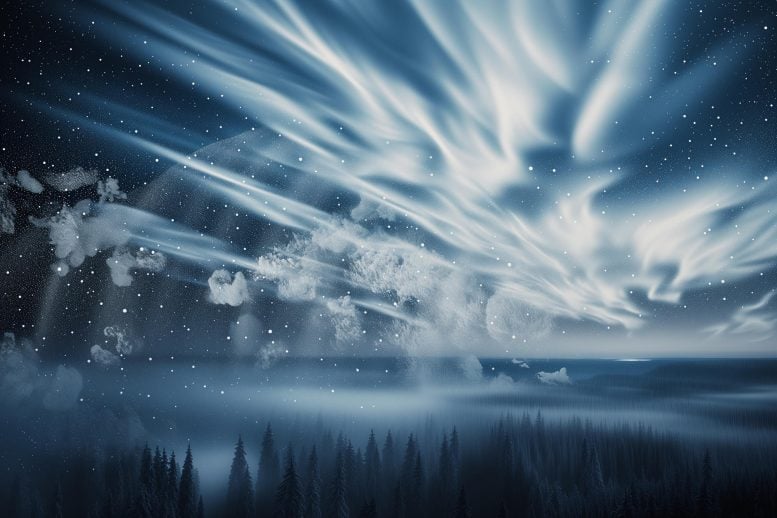
University of Helsinki researchers have discovered extensive aerosol particle formation in the West Siberian taiga, contradicting previous beliefs and linking it to heat wave conditions and a warming climate. This significant finding improves understanding of climate interactions, requiring more research in boreal forests to inform climate modeling and policy decisions. Credit: SciTechDaily.com
Contrary to previous assumptions, recent research has found that significant amounts of aerosol particles form over extensive areas of the West Siberian taiga during the spring. These findings indicate that rising temperatures due to this phenomenon will greatly affect the climate.
Aerosol particles contribute significantly to the Earth's cooling process. They can directly or indirectly affect the amount of sunlight reaching the Earth's surface by aiding cloud formation. These particles are formed from various gas molecules and are found all over the planet.
To understand the conditions under which these particles form, researchers are conducting measurements in various environments around the world. For example, the Finnish flagship station SMEAR II has conducted measurements in the boreal forest for 25 years.
However, the boreal forest is a very large area, and its contribution to aerosol formation has not yet been investigated, especially in its Siberian and Canadian regions.
Previous studies have suggested that particle formation in Siberia is rare. However, a recent study from the University of Helsinki shows that particle formation in Siberia is more frequent and linked to warmer conditions. The results of the study are published in the journal Environmental Research Letters.
„Contrary to what was previously thought, our results suggest that large amounts of aerosol particles may form over large areas of the West Siberian taiga during spring,” said Olga Karmash and Ekaterina Esova from the Institute for Atmospheric and Earth System Research. University of Helsinki.
The researchers also found that more aerosols are formed under heat wave conditions or in a warming climate, which may have a mitigating, cooling climate effect.
Ideal conditions created by heat
In 2020, researchers conducted a long-term measurement campaign using a suite of state-of-the-art instruments. Their initial aim was to determine why particles rarely form in Siberia.
„Especially in March, the particle-forming events continued one after the other, and they were much stronger than at the Finnish station SMEAR II,” says postdoctoral researcher Olga Karmash.
In 2020, Siberia was under a semi-annual heat wave. Using a multidisciplinary analysis of atmospheric chemistry, physics and weather, the researchers found that forest emissions, pollution and a heat wave created ideal conditions for aerosol formation. That year may be an exception to frequent new particle formation.
„However, with warming temperatures in Western Siberia, the same temperatures as under the 2020 heat wave will become common in the future. This frequent new particle formation may become normal. What consequences this will have on the climate remains an important open question,” says Ekaterina Esova, PhD in Geophysics and University Lecturer.
The purpose is to inform decision making
This is the first time such detailed measurements have been conducted in Siberia focusing on atmospheric aerosol particles. The researchers also discovered differences in atmospheric processes between the Siberian and Fennoscandian boreal forests.
„Because the boreal forest is the largest terrestrial biome, more measurements elsewhere are needed to understand forest-atmosphere interactions and feedbacks in a warming climate,” says Karmash.
„Our future work will benefit from collaboration with modelers: if the model reproduces observed aerosol formation, it can be used to estimate the effect of enhanced aerosol formation on clouds and precipitation. A potential application of our results is in the development and testing of models, particularly global Earth system models, that can be used to inform decision-making.” Esova says.
Note: „Heat Wave Reveals Potential for Enhanced Aerosol Formation in the Siberian Boreal Forest” by Olga Karmash, Ekaterina Yezhova, Mikhail Arshinov, Boris Belan, Anastasia Lampilahti, Denis Davydov, Meri Ratti, Diego Aliaga, Rima Balbaki, Rima Balbaki, Veliko Feli, Veliko Bachi. ” —Matti Kerminen, Dukka Petaja and Markku Kulmala, 9 January 2024, Environmental Research Letters.
DOI: 10.1088/1748-9326/ad10d5

„Oddany rozwiązywacz problemów. Przyjazny hipsterom praktykant bekonu. Miłośnik kawy. Nieuleczalny introwertyk. Student.
